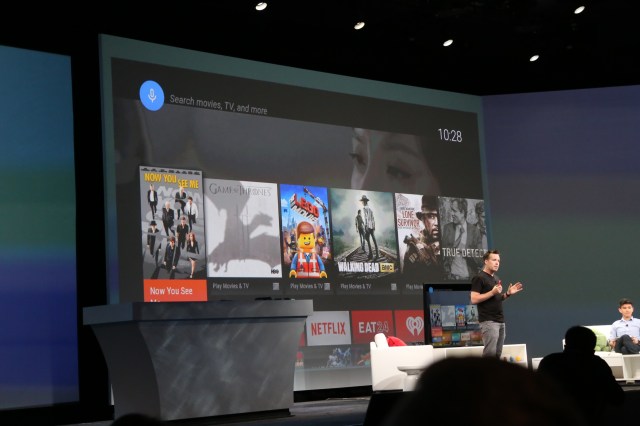As reported on TechCrunch.
by Ryan Lawler
 Google has spent many years trying to find its way onto the biggest screen in the house. Today at its I/O developer conference, the the company introduced yet another product that it hopes will accomplish that goal — a new Android TV operating system.
Google has spent many years trying to find its way onto the biggest screen in the house. Today at its I/O developer conference, the the company introduced yet another product that it hopes will accomplish that goal — a new Android TV operating system.
Contrary to reports, Android TV isn’t a set-top box like Apple TV or Amazon Fire TV, but a software system that will be embedded into the smart TVs and other devices from third-party OEMs.
Unlike its first effort in smart TV software, Google TV, Android TV will work with a number of different chipsets. And it’s designed to enable Android developers to create apps using the same Android toolset that they use for mobile phones and tablets.
Android TV will play movies and TV shows, and users will be able to control it via mobiles phones and tablets. Google Engineering Director Dave Burke showed off how the system works to enable search and navigation either via text or voice. He even showed off the ability to control the TV via an Android Gear smartwatch.
In addition to controlling live TV and on-demand shows via a set of streaming apps, users can play games using the platform. Those games can be controlled via smartphones and tablets as well, with control streamed to the TV.
Android TV will have full Chromecast support, so users can beam content from their mobile devices straight to the TV. The new platform also enables users to launch an app store developed specifically for a 10′ UI.
The Android TV platform will run on a line of smart TVs from Sony, Sharp and TPVision, and will soon run on other set-top boxes that will become available later in the year from the likes of Asus and others.
Depending on how you count it, this could be Google’s third or fourth try to insert its dominance into TV. Back in 2010, Google introduced its Google TV operating system with a series of partners that committed to embedding its software onto their smart TV sets.
But that initiative failed in part due to the high costs associated with the components that were necessary to run the software, which ended up driving the price of products from Sony, Logitech, and others higher than other smart TVs. Then two years ago, Google announced the Nexus Q, a streaming media player that was so poorly received that it never actually made it into mass production.
More recently, Google has seen a lot of success with its $35 Chromecast dongle, which enables users to beam videos to their TV from a mobile phone or tablet. The device, which is routinely one of the top sellers on sites like Amazon.com, has also gotten dozens of developers on board to connect with its API.
Of course, a lot will depend on the price of Android TV devices that are released. But if they are competitive with other smart TV platforms, Google might finally succeed in getting OEM and developer support in the living room.